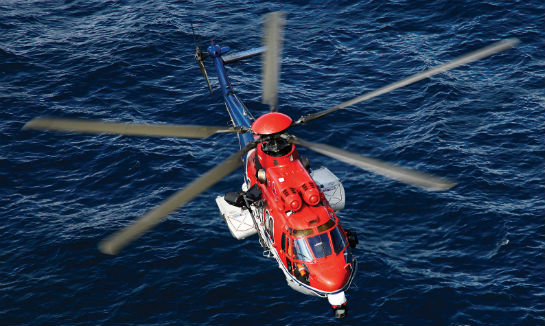
The ban expands an earlier restriction of flight activity with the two types to include search-and-rescue (SAR) operations. Those affected include Norwegian oil producer Statoil, which uses H225s in its SAR emergency service from the Oseberg Field Centre, Statfjord B platform and at Sola. In a statement released earlier today, it said it had mobilized two extra Sikorsky S-92s to replace the aircraft and respond to any necessary medical evacuation.
The grounding follows the release of the latest preliminary report from the Accident Investigation Board of Norway (AIBN), which included an urgent safety recommendation calling on EASA to take “immediate action to ensure the safety of the Airbus Helicopters H225 main gearbox,” following metallurgical examinations on the wreckage of the aircraft (registration LN-OJF) that crashed near Turøy.
“Recent metallurgical findings have revealed features strongly consistent with fatigue in the outer race of a second stage planet gear in the epicyclic module of the MGB [main gearbox],” the AIBN stated in its June 1 report. “It cannot be ruled out that this signifies a possible safety issue that can affect other MGBs of the same type. The nature of the catastrophic failure of the LN-OJF main rotor system indicates that the current means to detect a failure in advance are not effective.”
The AIBN said detailed metallurgical examinations have been ongoing since May 19, with several parts from the second stage epicyclic module retrieved from the accident site. Among the recovered parts were two pieces which together form approximately half a second stage planet gear.
“Examinations of these parts have revealed features strongly consistent with fatigue,” the AIBN report states. “The fatigue appears to have its origin in the outer race of the bearing (inside of the gear), propagating towards the web of the gear teeth. There is sign of spalling in front of the fracture surface.”
Although preliminary, the AIBN said it considered its findings “to be of such significance that it has decided to issue the safety recommendation to ensure the continuing airworthiness of the main gearbox.”
On the same day that the AIBN released its lastest update, EASA issued an Emergency Airworthiness Directive (EAD) that called for further inspection and replacement instructions to ensure the correct installation of the H225/EC225LP’s MGB suspension bars and attachment fittings. The directive followed an earlier EAD that required several one-off inspections of the type’s main gearbox as a “precautionary measure.” EASA said data from those completing the original EAD revealed tightening torque values on the attachment bolts of the MGB upper deck fittings of the three MGB suspension bars being out of tolerance, and some incorrect washer positioning in the fitting assemblies.
Among other actions, the EAD requires the replacement of the attachment hardware of the MGB suspension bar fittings and related base plate assemblies, followed by a readjustment of the tightening torque of the MGB suspension bar following at least 10 flight hours, but no more than 50 flight hours. On June 2, EASA announced it had decided to prohibit all flights by H225/EC225LP and AS332L2 helicopters “as a precautionary measure and until further information is available.”
The latest developments follow an AIBN update from May 27, in which it said the scenarios under consideration for the cause of the crash included failure of the epicyclic module, suspension bar (lift strut) attachment, and main gearbox conical housing.
According to an Airbus Helicopters statement released following the publication of the May 27 update, the manufacturer’s analysis pointed to just seven potential initial events causing the accident aircraft’s main rotor to detach.
“Out of these seven scenarios, only one – the failure of the attachment of a suspension bar – can been assessed as probable by Airbus Helicopters, based on the information available to date,” the manufacturer stated.
However, a few days later, Airbus sought to clarify its position when it released a statement that it was “not ruling out any of the scenarios described by the AIBN in its updated preliminary report” into the accident, and that “more work needs to be done on scenarios involving the epicyclic module and the MGB conical housing.”
The crash took place as the aircraft, which was carrying 11 passengers and two crew, was returning to Bergen Airport Flesland from the Gullfaks B platform in the North Sea. The detachment of the main rotor head and mast caused the fuselage to plummet into a small island below, killing all 13 on board. The main wreckage caught fire following the crash, and then fell into the sea, while the main rotor eventually came to a rest several hundred meters away from the crash site.
The H225/EC225LP was grounded for commercial operations by the U.K. and Norwegian civil aviation authorities in the aftermath of the crash (and the grounding was later extended to the AS332L2). Following EASA’s initial EAD, Airbus Helicopters issued its own emergency Alert Service Bulletin, requiring, as a precautionary measure, the verification of the correct installation of all main gearbox suspension bar attachments in the H225.









